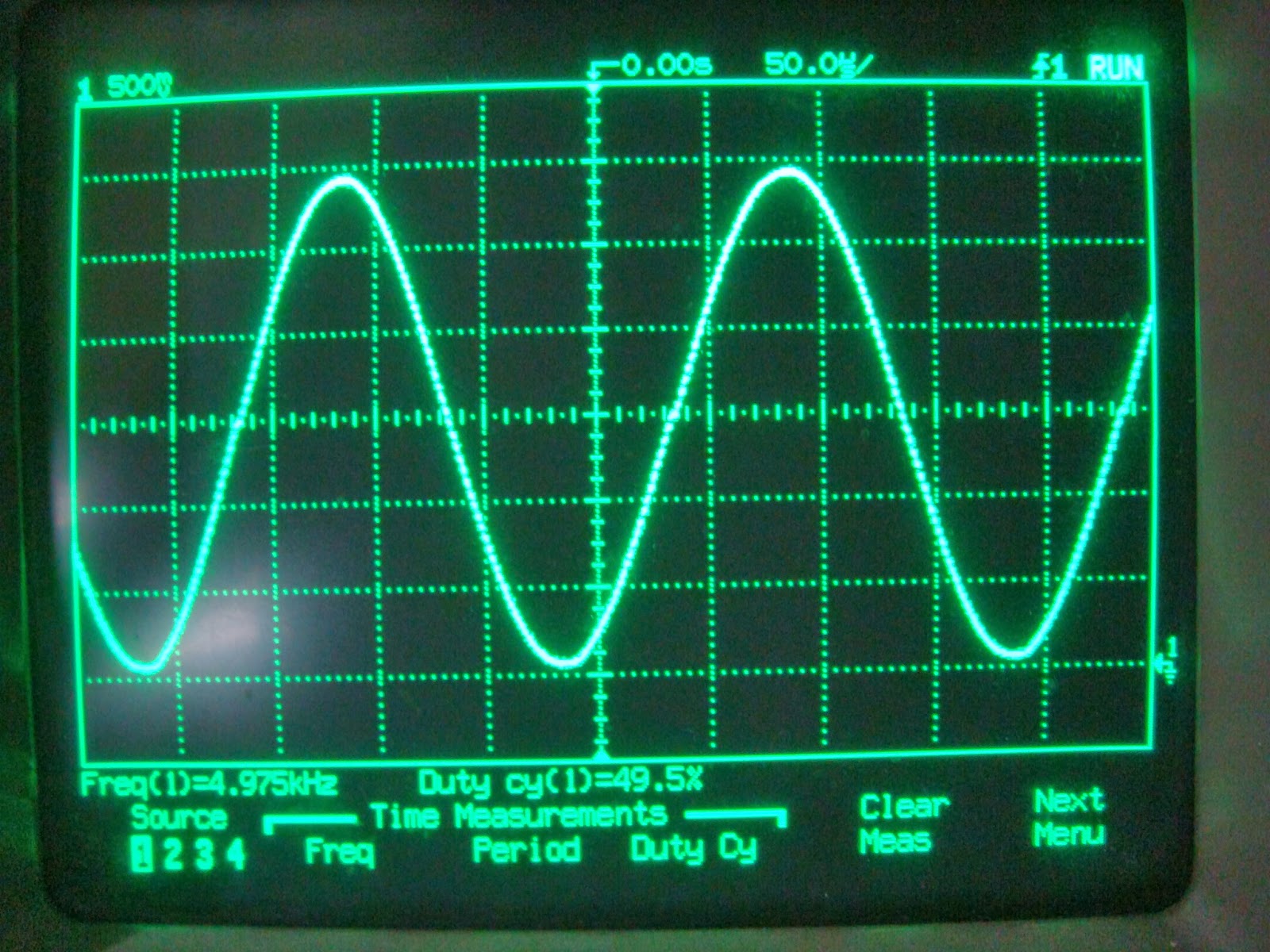STM32 F4 DAC DMA Waveform Generator
Goal: generating an arbitrary periodic waveform using a DAC with DMA and TIM6 as a trigger.
Agenda:
- Modeling a waveform in MATLAB and getting the waveform data
- Studying the DAC, DMA, and TIM6 to see how it can be used to generate a waveform
- Coding and testing a couple of functions
%% Generating an n-bit sine wave % Modifiable parameters: step, bits, offset close; clear; clc; points = 128; % number of points between sin(0) to sin(2*pi) bits = 12; % 12-bit sine wave for 12-bit DAC offset = 75; % limiting DAC output voltage t = 0:((2*pi/(points-1))):(2*pi); % creating a vector from 0 to 2*pi y = sin(t); % getting the sine values y = y + 1; % getting rid of negative values (shifting up by 1) y = y*((2^bits-1)-2*offset)/2+offset; % limiting the range (0+offset) to (2^bits-offset) y = round(y); % rounding the values plot(t, y); grid % plotting for visual confirmation fprintf('%d, %d, %d, %d, %d, %d, %d, %d, %d, %d, ', y);

There's a trade-off between the sine wave resolution (number of points from sin(0) to sin(2*pi)), output frequency range, and precision of the output frequency (e.g. we want a 20kHz wave, but we can only get 19.8kHz or 20.2kHz because the step is 0.4kHz). The output frequency is a non-linear function with multiple variables. To complicate it further, some of these variables must be integers within 1 to 65535 range which makes it impossible to output certain frequencies precisely.
Although precise frequency control is terribly hard (if not impossible), one feature does stand out - ability to generate a periodic waveform of any shape.
Below is the code for mediocre range/precision/resolution but excellent versatility in terms of shaping the output waveform.
@input - uint16_t function[waveform_resolution]
@output - PA4 in analog configuration
@parameters - OUT_FREQ, SIN_RES
To tailor other parameters, study the DAC channel block diagram, electrical characteristics, timing diagrams, etc. To switch DAC channels, see memory map, specifically DAC DHRx register for DMA writes.
#include <stm32f4xx.h> #include "other_stuff.h" #define OUT_FREQ 5000 // Output waveform frequency #define SINE_RES 128 // Waveform resolution #define DAC_DHR12R1_ADDR 0x40007408 // DMA writes into this reg on every request #define CNT_FREQ 42000000 // TIM6 counter clock (prescaled APB1) #define TIM_PERIOD ((CNT_FREQ)/((SINE_RES)*(OUT_FREQ))) // Autoreload reg value const uint16_t function[SINE_RES] = { 2048, 2145, 2242, 2339, 2435, 2530, 2624, 2717, 2808, 2897, 2984, 3069, 3151, 3230, 3307, 3381, 3451, 3518, 3581, 3640, 3696, 3748, 3795, 3838, 3877, 3911, 3941, 3966, 3986, 4002, 4013, 4019, 4020, 4016, 4008, 3995, 3977, 3954, 3926, 3894, 3858, 3817, 3772, 3722, 3669, 3611, 3550, 3485, 3416, 3344, 3269, 3191, 3110, 3027, 2941, 2853, 2763, 2671, 2578, 2483, 2387, 2291, 2194, 2096, 1999, 1901, 1804, 1708, 1612, 1517, 1424, 1332, 1242, 1154, 1068, 985, 904, 826, 751, 679, 610, 545, 484, 426, 373, 323, 278, 237, 201, 169, 141, 118, 100, 87, 79, 75, 76, 82, 93, 109, 129, 154, 184, 218, 257, 300, 347, 399, 455, 514, 577, 644, 714, 788, 865, 944, 1026, 1111, 1198, 1287, 1378, 1471, 1565, 1660, 1756, 1853, 1950, 2047 }; static void TIM6_Config(void); static void DAC1_Config(void); int main() { GPIO_InitTypeDef gpio_A; RCC_AHB1PeriphClockCmd(RCC_AHB1Periph_GPIOA, ENABLE); RCC_APB1PeriphClockCmd(RCC_APB1Periph_DAC, ENABLE); RCC_AHB1PeriphClockCmd(RCC_AHB1Periph_DMA1, ENABLE); gpio_A.GPIO_Pin = GPIO_Pin_4; gpio_A.GPIO_Mode = GPIO_Mode_AN; gpio_A.GPIO_PuPd = GPIO_PuPd_NOPULL; GPIO_Init(GPIOA, &gpio_A); TIM6_Config(); DAC1_Config(); while (1) { } } static void TIM6_Config(void) { TIM_TimeBaseInitTypeDef TIM6_TimeBase; RCC_APB1PeriphClockCmd(RCC_APB1Periph_TIM6, ENABLE); TIM_TimeBaseStructInit(&TIM6_TimeBase); TIM6_TimeBase.TIM_Period = (uint16_t)TIM_PERIOD; TIM6_TimeBase.TIM_Prescaler = 0; TIM6_TimeBase.TIM_ClockDivision = 0; TIM6_TimeBase.TIM_CounterMode = TIM_CounterMode_Up; TIM_TimeBaseInit(TIM6, &TIM6_TimeBase); TIM_SelectOutputTrigger(TIM6, TIM_TRGOSource_Update); TIM_Cmd(TIM6, ENABLE); } static void DAC1_Config(void) { DAC_InitTypeDef DAC_INIT; DMA_InitTypeDef DMA_INIT; DAC_INIT.DAC_Trigger = DAC_Trigger_T6_TRGO; DAC_INIT.DAC_WaveGeneration = DAC_WaveGeneration_None; DAC_INIT.DAC_OutputBuffer = DAC_OutputBuffer_Enable; DAC_Init(DAC_Channel_1, &DAC_INIT); DMA_DeInit(DMA1_Stream5); DMA_INIT.DMA_Channel = DMA_Channel_7; DMA_INIT.DMA_PeripheralBaseAddr = (uint32_t)DAC_DHR12R1_ADDR; DMA_INIT.DMA_Memory0BaseAddr = (uint32_t)&function; DMA_INIT.DMA_DIR = DMA_DIR_MemoryToPeripheral; DMA_INIT.DMA_BufferSize = SINE_RES; DMA_INIT.DMA_PeripheralInc = DMA_PeripheralInc_Disable; DMA_INIT.DMA_MemoryInc = DMA_MemoryInc_Enable; DMA_INIT.DMA_PeripheralDataSize = DMA_PeripheralDataSize_HalfWord; DMA_INIT.DMA_MemoryDataSize = DMA_MemoryDataSize_HalfWord; DMA_INIT.DMA_Mode = DMA_Mode_Circular; DMA_INIT.DMA_Priority = DMA_Priority_High; DMA_INIT.DMA_FIFOMode = DMA_FIFOMode_Disable; DMA_INIT.DMA_FIFOThreshold = DMA_FIFOThreshold_HalfFull; DMA_INIT.DMA_MemoryBurst = DMA_MemoryBurst_Single; DMA_INIT.DMA_PeripheralBurst = DMA_PeripheralBurst_Single; DMA_Init(DMA1_Stream5, &DMA_INIT); DMA_Cmd(DMA1_Stream5, ENABLE); DAC_Cmd(DAC_Channel_1, ENABLE); DAC_DMACmd(DAC_Channel_1, ENABLE); }
Using the code above we are supposed to get a 5kHz sine wave constructed with 128 points (for better quality, consider using more points).
Here's a picture of what we actually get (off by 25Hz, not too bad).

And here's the cool sinc(x) function. To generate other functions, model it in MATLAB, cast to 12-bit, STM32F4 does the rest.
